Determination of Lidar Ratio for Major Aerosol Types over Western North Pacific Based on Long-Term MPLNET Data
Abstract
1. Introduction
2. Methodology
2.1. Site Description
2.2. Ground-Based Remote Sensing Observations
2.3. Source Identification Through Back Trajectory Analysis
3. Results
3.1. Long-Term Data Analysis of Aerosol Optical Properties
3.2. Monthly Aerosol Extinction Profiles
3.3. Aerosol Vertical Distribution, Source Region, and Optical Properties
3.3.1. Characteristics of Single-Layer Aerosol Structure
3.3.2. Characteristics of Two-Layer Aerosol Structure
- Two-layer aerosol structure (dust case): Sandstorm pollution recorded by the EPA on the same day and the main source of air mass from the AC region (mainly from the elevated regions over northern China and Mongolia and covered the longest distance along China’s coast). Those mineral dust particles usually transport near the surface behind of a frontal system, and occasionally intrude to higher levels via frontal dynamics.
- Two-layer aerosol structure (biomass-burning case): Transport of springtime biomass-burning emissions from the source regions over SA (comprising Cambodia, Laos, Myanmar, and Thailand). Those aerosols mainly transport in free atmosphere and arrive in Taiwan at higher elevation.
3.4. Dust Case
3.5. Biomass-Burning Case
4. Discussion
5. Conclusions
- The long-term average values of τ500, α440/870, and Sp were found to be 0.41 ± 0.28, 1.25 ± 0.33, and (47 ± 21) sr, respectively.
- The highest τ500 (0.72 ± 0.28) and Sp (54 ± 23 sr) values in the month of March were primarily attributed to the long-range transport of biomass-burning aerosols from Indochina.
- Two types of aerosol structure were classified based on the vertical cross-sections of aerosols. Type 1 aerosol structure (near-surface aerosol transport mainly prevails during October–November) showed low values τ500 and Sp and mainly originated from the AC region (τ500: 0.24 ± 0.11; Sp: 39 ± 8 sr), PO region (0.19 ± 0.10; 30 ± 12 sr), and SA region (0.19 ± 0.11; 38 ± 17 sr).
- Type 2 aerosol transport (mainly during March–April at an altitude of 3 to 6 km) was associated with high τ500 (0.51 ± 0.22), α440/870 (1.23 ± 0.26), and Sp (52 ± 23 sr).
- For type 2 dust case, the estimated τ500, α440/870, and Sp were found to be 0.45 ± 0.16, 1.10 ± 0.24, and (40 ± 16) sr, respectively. For type 2 biomass-burning case, the estimated τ500, α440/870, and Sp were found to be 0.58 ± 0.20, 1.22 ± 0.33, and (53 ± 21) sr, respectively.
- Sp values, for four major aerosol types over northern Taiwan, were estimated to be 42 ± 18 sr (urban), 34 ± 6 sr (dust), 69 ± 12 sr (biomass-burning), and 30 ± 12 sr (oceanic).
Author Contributions
Funding
Acknowledgments
Conflicts of Interest
References
- Charlson, R.J.; Schwartz, S.E.; Hales, J.M.; Cess, R.D.; Coakley, J.D.; Hansen, J.E.; Hofmann, D.J. Climate forcing by anthropogenic aerosols. Science 1992, 255, 423–430. [Google Scholar] [CrossRef] [PubMed]
- Penner, J.E.; Charlson, R.J.; Hales, J.M.; Laulainen, N.S.; Leifer, R.; Novakov, T.; Ogren, J.; Radke, L.F.; Schwartz, S.E.; Travis, L. Quantifying and minimizing uncertainty of climate forcing by anthropogenic aerosols. Bull. Am. Meteorol. Soc. 1994, 75, 375–400. [Google Scholar] [CrossRef]
- Intergovernmental Panel on Climate Change. Climate Change 2007, Working Group I Report—The Physical Science Basis; Solomon, S., Qin, D., Manning, M., Marquis, M., Averyt, K., Tignor, M.M.B., LeRoy Miller, H., Jr., Chen, Z., Eds.; Cambridge University Press: New York, NY, USA, 2007. [Google Scholar]
- Kaufman, Y.J.; Tanre, D.; Gordon, H.R.; Nakajima, T.; Lenoble, J.; Frouin, R.; Grassl, H.; Hermann, B.M.; King, M.D.; Teillet, P.M. Passive Remote Sensing of Tropospheric Aerosol and Atmospheric Correction for the Aerosol Effect. J. Geophys. Res. 1997, 102, 16815–16830. [Google Scholar] [CrossRef]
- Yu, H.B.; Chin, M.; Winker, D.M.; Omar, A.H.; Liu, C.K.; Diehl, T. Global View of Aerosol Vertical Distributions from CALIPSO Lidar Measurements and GOCART Simulations: Regional and Seasonal Variations. J. Geophys. Res. 2010, 115, D00H30. [Google Scholar] [CrossRef]
- Haywood, J.M.; Ramaswamy, V. Global sensitivity studies of the direct radiative forcing due to anthropogenic sulfate and blackcarbon aerosols. J. Geophys. Res. 1998, 103, 6043–6058. [Google Scholar] [CrossRef]
- Gadhavi, H.; Jayaraman, A. Airborne lidar study of the vertical distribution of aerosols over Hyderabad, an urban site in central India, and its implication for radiative forcing calculations. Ann. Geophys. 2006, 24, 2461–2470. [Google Scholar] [CrossRef]
- Chew, B.N.; Campbell, J.; Hyer, E.J.; Salinas, S.V.; Reid, J.S.; Welton, E.J.; Holben, B.N.; Liew, S.C. Relationship between aerosol optical depth and particulate matter over Singapore: Effects of aerosol vertical distributions. Aerosol Air Qual. Res. 2016, 16, 2818–2830. [Google Scholar] [CrossRef]
- Wang, S.-H.; Welton, E.J.; Holben, B.N.; Tsay, S.-C.; Lin, N.-H.; Giles, D.; Stewart, S.A.; Janjai, S.; Nguyen, X.A.; Hsiao, T.-C. Vertical distribution and columnar optical properties of springtime biomass-burning aerosols over Northern Indochina during 2014 7-SEAS campaign. Aerosol Air Qual. Res. 2015, 15, 2037–2050. [Google Scholar] [CrossRef]
- Hee, W.S.; San Lim, H.; Jafri, M.Z.M.; Lolli, S.; Ying, K.W. Vertical profiling of aerosol types observed across monsoon seasons with a Raman lidar in Penang Island, Malaysia. Aerosol Air Qual. Res. 2016, 16, 2843–2854. [Google Scholar] [CrossRef]
- Muñoz Magnino, R.; Alcafuz, R.I. Variability of urban aerosols over Santiago, Chile: Comparison of surface PM10 concentrations and remote sensing with ceilometer and lidar. Aerosol Air Qual. Res. 2012, 12, 8–19. [Google Scholar] [CrossRef]
- Jayaraman, A.; Subbaraya, B.H. In situ measurements of aerosol extinction profiles and their spectral dependencies at tropospheric levels. Tellus 1993, 45B, 473–478. [Google Scholar] [CrossRef]
- Ramachandran, S.; Jayaraman, A. Balloon-borne study of the upper tropospheric and stratospheric aerosols over a tropical station in India. Tellus 2003, 55B, 820–836. [Google Scholar] [CrossRef]
- He, Q.S.; Li, C.C.; Mao, J.T.; Lau, A.K.H. A study on aerosol extinction-to-backscatter ratio with combination of micro-pulse lidar and MODIS over Hong Kong. Atmos. Chem. Phys. 2006, 6, 3243–3256. [Google Scholar] [CrossRef]
- Devara, P.C.S.; Raj, P.E.; Pandithurai, G. Aerosol-profile measurements in the lower troposphere with four-wavelength bistatic argon-ion lidar. Appl. Opt. 1995, 34, 4416–4425. [Google Scholar] [CrossRef]
- Parameswaran, K.; Rajan, R.; Vijayakumar, G.; Rajeev, K.; Moorthy, K.K.; Nair, P.R.; Satheesh, S.K. Seasonal and long term variations of aerosol content in the atmospheric mixing region at a tropical station on the Arabian sea-coast. J. Atmos. Sol. Terr. Phys. 1998, 60, 17–25. [Google Scholar] [CrossRef]
- Welton, E.J.; Voss, K.J.; Gordon, H.R.; Maring, H.; Smirnov, A.; Holben, B.N.; Schmid, B.; Livingston, J.M.; Russell, P.B.; Durkee, P.A.; et al. Ground-based lidar measurements of aerosols during ACE-2: Lidar description, results, and comparisons with other ground-based and airborne measurements. Tellus 2000, 52B, 636–651. [Google Scholar] [CrossRef]
- Chen, W.B.; Kuze, H.; Uchiyama, A.; Suzuki, Y.; Takeuchi, N. One-year observation of urban mixed layer characteristics at Tsukuba, Japan using a micro pulse lidar. Atmos. Environ. 2001, 35, 4273–4280. [Google Scholar] [CrossRef]
- Campbell, J.R.; Welton, E.J.; Spinhirne, J.D.; Ji, Q.; Tsay, S.; Piketh, S.J.; Barenbrug, M.; Holben, B.N. Micropulse lidar observations of tropospheric aerosols over northeastern South Africa during the ARREX and SAFARI 2000 dry season experiments. J. Geophys. Res. 2003, 108, 8497. [Google Scholar] [CrossRef]
- Schmid, B.; Ferrare, R.; Flynn, C.; Elleman, R.; Covert, D.; Strawa, A.; Welton, E.; Turner, D.; Jonsson, H.; Redemann, J. How well do state-of-the-art techniques measuring the vertical profile of tropospheric aerosol extinction compare? J. Geophys. Res. 2006, 111, D05S07. [Google Scholar] [CrossRef]
- Hayasaka, T.; Satake, S.; Shimizu, A.; Sugimoto, N.; Matsui, I.; Aoki, K.; Muraji, Y. Vertical distribution and optical properties of aerosols observed over Japan during the Atmospheric Brown Clouds–East Asia Regional Experiment 2005. J. Geophys. Res. 2007, 112, D22S35. [Google Scholar] [CrossRef]
- He, Q.; Li, C.; Mao, J.; Lau, A.K.-H.; Chu, D.A. Analysis of aerosol vertical distribution and variability in Hong Kong. J. Geophys. Res. 2008, 113, D14211. [Google Scholar] [CrossRef]
- Wang, S.-H.; Lin, N.-H.; Chou, M.-D.; Tsay, S.-C.; Welton, E.J.; Hsu, N.C.; Giles, D.M.; Liu, G.-R.; Holben, B.N. Profiling transboundary aerosols over Taiwan and assessing their radiative effects. J. Geophys. Res. 2010, 115, D00K731. [Google Scholar] [CrossRef]
- Kent, G.S.; Trpte, C.R.; Lucker, P.L. Long-term Stratospheric Aerosol and Gas Experiment I and II measurements of upper tropospheric aerosol extinction. J. Geophys. Res. 1998, 103, 28863–28874. [Google Scholar] [CrossRef]
- Spinhirne, J.D.; Palm, S.P.; Hart, W.D.; Hlavka, D.L.; Welton, E.J. Cloud and aerosol measurements from GLAS: Overview and initial results. Geophys. Res. Lett. 2005, 32, L22S03. [Google Scholar] [CrossRef]
- Mamouri, R.-E.; Ansmann, A. Potential of polarization lidar to provide profiles of CCN- and INP-relevant aerosol parameters. Atmos. Chem. Phys. 2016, 16, 5905–5931. [Google Scholar]
- Sassen, K.; Cho, B.S. Subvisual-Thin Cirrus LIDAR Dataset for Satellite Verification and Climatological Research. J. Appl. Meteorol. 1992, 31, 1275–1285. [Google Scholar] [CrossRef]
- Welton, E.J.; Voss, K.J.; Flatau, P.J.; Markowicz, K.; Campbell, J.R.; Spinhirne, J.D.; Gordon, H.R.; Johnson, J.E. Measurements of aerosol vertical profiles and optical properties during INDOEX 1999 using micropulse lidars. J. Geophys. Res. 2002, 107, 8019. [Google Scholar] [CrossRef]
- Pelon, J.; Flamant, C.; Chazette, P.; Leon, J.-F.; Tanre, D.; Sicard, M.; Satheesh, S.K. Characterization of aerosol spatial distribution and optical properties over the Indian Ocean from airborne LIDAR and radiometry during INDOEX’99. J. Geophys. Res. 2002, 107, 8029. [Google Scholar] [CrossRef]
- McGill, M.J.; Hlavka, D.L.; Hart, W.D.; Welton, E.J.; Campbell, J.R. Airborne lidar measurements of aerosol optical properties during SAFARI-2000. J. Geophys. Res. 2003, 108, 8493. [Google Scholar] [CrossRef]
- Flamant, C.; Pelon, J.; Chazette, P.; Trouillet, V.; Quinn, P.K.; Frouin, R.; Bruneau, D.; Leon, J.-F.; Bates, T.; Johnson, J.; et al. Airborne lidar measurements of aerosol spatial distribution and optical properties over the Atlantic Ocean during an European pollution outbreak of ACE-2. Tellus 2000, 52B, 662–677. [Google Scholar] [CrossRef]
- Tsay, S.C.; Hsu, N.C.; Lau, W.K.M.; Li, C.; Gabriel, P.M.; Ji, Q.; Holben, B.N.; Judd Welton, E.; Nguyen, A.X.; Janjai, S.; et al. From BASE-ASIA toward 7-SEAS: A satellite-surface perspective of boreal spring biomass-burning aerosols and clouds in Southeast Asia. Atmos. Environ. 2013, 78, 20–34. [Google Scholar] [CrossRef]
- Wang, S.-H.; Tsay, S.-C.; Lin, N.-H.; Chang, S.-C.; Li, C.; Welton, E.J.; Holben, B.N.; Hsu, N.C.; Lau, K.-M.; Lolli, S.; et al. Origin, transport, and vertical distribution of atmospheric pollutants over the northern South China Sea during 7-SEAS/Dongsha experiment. Atmos. Environ. 2013, 78, 124–133. [Google Scholar] [CrossRef]
- Shin, S.-K.; Tesche, M.; Noh, Y.; Müller, D. Aerosol-type classification based on AERONET version 3 products. Atmos. Meas. Tech. 2019, 12, 3789–3803. [Google Scholar] [CrossRef]
- Siomos, N.; Fountoulakis, I.; Natsis, A.; Drosoglou, T.; Bais, A. Automated Aerosol Classification from Spectral UV Measurements Using Machine Learning Clustering. Remote Sens. 2020, 12, 965. [Google Scholar] [CrossRef]
- Chen, Q.-X.; Huang, C.-L.; Yuan, Y.; Mao, Q.-J.; Tan, H.-P. Spatiotemporal Distribution of Major Aerosol Types over China Based on MODIS Products between 2008 and 2017. Atmosphere 2020, 11, 703. [Google Scholar] [CrossRef]
- Nicolae, D.; Vasilescu, J.; Talianu, C.; Binietoglou, I.; Nicolae, V.; Andrei, S.; Antonescu, B. A neural network aerosol-typing algorithm based on lidar data. Atmos. Chem. Phys. 2018, 18, 14511–14537. [Google Scholar] [CrossRef]
- Ansmann, A.; Seifert, P.; Tesche, M.; Wandinger, U. Profiling of fine and coarse particle mass: Case studies of Saharan dust and Eyjafjallajökull/Grimsvötn volcanic plumes. Atmos. Chem. Phys. 2012, 12, 9399–9415. [Google Scholar] [CrossRef]
- Kim, M.-H.; Omar, A.H.; Tackett, J.L.; Vaughan, M.A.; Winker, D.M.; Trepte, C.R.; Hu, Y.; Liu, Z.; Poole, L.R.; Pitts, M.C.; et al. The CALIPSO version 4 automated aerosol classification and lidar ratio selection algorithm. Atmos. Meas. Tech. 2018, 11, 6107–6135. [Google Scholar] [CrossRef]
- Georgoulias, A.K.; Marinou, E.; Tsekeri, A.; Proestakis, E.; Akritidis, D.; Alexandri, G.; Zanis, P.; Balis, D.; Marenco, F.; Tesche, M.; et al. A first case study of CCN concentrations from spaceborne lidar observations. Remote Sens. 2020, 12, 1557. [Google Scholar] [CrossRef]
- Ackermann, J. The extinction-to-backscattering ratio oftropospheric aerosol: A numerical study. J. Atmos. Ocean. Technol. 1998, 15, 1043–1050. [Google Scholar] [CrossRef]
- Perez-Ramirez, D.; Whiteman, D.N.; Veselovskii, I.; Colarco, P.; Korenski, M.; da Silva, A. Retrievals of aerosol single scattering albedo by multiwavelength lidar measurements: Evaluations with NASA Langley HSRL-2 during discover-AQ field campaigns. Remote Sens. Environ. 2019, 222, 144–164. [Google Scholar] [CrossRef]
- Burton, S.P.; Ferrare, R.A.; Hostetler, C.A.; Hair, J.W.; Rogeres, R.R.; Obland, M.D.; Obland, M.D.; Butler, C.F.; Cook, A.L.; Harper, D.B.; et al. Aerosol classification using airborne High Spectral Resolution Lidar measurements—Methodology and examples. Atmos. Meas. Tech. 2012, 5, 73–98. [Google Scholar] [CrossRef]
- Burton, S.P.; Ferrare, R.A.; Vaughan, M.A.; Omar, A.H.; Rogers, R.R.; Hostetler, C.; Hair, J.W. Aerosol classification from airborne HSRL and comparisons with the CALIPSO vertical feature mask. Atmos. Meas. Tech. 2013, 6, 1397–1412. [Google Scholar] [CrossRef]
- Burton, S.P.; Vaughan, M.A.; Ferrare, R.A.; Hostetler, C.A. Separating mixtures of aerosol types in airborne High Spectral Resolution Lidar data. Atmos. Meas. Tech. 2014, 7, 419–436. [Google Scholar] [CrossRef]
- Streets, D.G.; Bond, T.C.; Carmichael, G.R.; Fernandes, S.D.; Fu, Q.; He, D.; Klimont, Z.; Nelson, S.M.; Tsai, N.Y.; Wang, M.Q.; et al. An inventory of gaseous and 10 primary aerosol emissions in Asia in the year 2000. J. Geophys. Res. 2003, 108, 8809. [Google Scholar] [CrossRef]
- Wenig, M.; Spichtinger, N.; Stohl, A.; Held, G.; Beirle, S.; Wagner, T.; Jahne, B.; Platt, U. Intercontinental transport of nitrogen oxide pollution plumes. Atmos. Chem. Phys. 2003, 3, 387–393. [Google Scholar] [CrossRef]
- Chiang, C.-W.; Das, S.K.; Nee, J.-B. An iterative calculation to derive extinction-to-backscatter ratio based on lidar measurements. J. Quant. Spectrosc. Radiat. Transf. 2008, 109, 1187–1193. [Google Scholar] [CrossRef]
- Lin, N.-H.; Tsay, S.C.; Maring, H.B.; Yen, M.C.; Sheu, G.R.; Wang, S.H.; Chi, K.H.; Chuang, M.T.; Ou-Yang, C.F.; Fu, J.S.; et al. An overview of regional experiments on biomass burning aerosols and related pollutants in Southeast Asia: From BASE-ASIA and the Dongsha Experiment to 7-SEAS. Atmos. Environ. 2013, 78, 1–19. [Google Scholar] [CrossRef]
- Chen, W.-N.; Tsao, C.C.; Nee, J.B. Tropospheric and Lower Stratospheric Temperature Measurement by Rayleigh Lidar. J. Atmos. Sol. -Terr. Phys. 2004, 66, 39–49. [Google Scholar] [CrossRef]
- Chen, W.-N.; Tsai, F.-J.; Chou, C.C.-K.; Chang, S.-Y.; Chen, I.-W.; Chen, J.-P. Cases studies of Asian Dust in the Free Atmosphere by Raman Depolarization Lidar at Taipei, Taiwan. Atmos. Environ. 2007, 41, 7698–7714. [Google Scholar] [CrossRef]
- Chen, W.-N.; Tsai, F.-J.; Chou, C.C.-K.; Chang, S.-Y.; Chen, Y.-W.; Chen, J.-P. Cases Study of Relationship Between Water-soluble Ca2+ and Lidar Depolarization Ratio for Spring Aerosol in the Boundary Layer. Atmos. Environ. 2007, 41, 1440–1455. [Google Scholar]
- Chen, W.-N.; Chen, Y.-W.; Chou, C.C.-K.; Chang, S.-Y.; Lin, P.-H.; Chen, J.-P. Columnar optical properties of tropospheric aerosol by combined lidar and sunphotometer measurements at Taipei, Taiwan. Atmos. Environ. 2009, 43, 2700–2716. [Google Scholar] [CrossRef]
- Tsai, J.-H.; Hsu, Y.-C.; Yang, J.-Y. The relationship between volatile organic profiles and emission sources in ozone episode region, a case study in southern Taiwan. Sci. Total Environ. 2004, 328, 131–142. [Google Scholar] [CrossRef] [PubMed]
- Omar, A.H.; Winker, D.M.; Vaughan, M.A.; Hu, Y.; Trepte, C.R.; Ferrare, R.A.; Lee, K.-P.; Hostetler, C.A.; Kittaka, C.; Rogers, R.R.; et al. The CALIPSO Automated Aerosol Classification and Lidar Ratio Selection Algorithm. J. Atmos. Ocean. Technol. 2009, 26, 23–32. [Google Scholar] [CrossRef]
- Liu, C.-M.; Young, C.-Y.; Lee, Y.-C. Influence of Asian Dust Storms on Air Quality in Taiwan. Sci. Total. Environ. 2006, 368, 884–897. [Google Scholar] [CrossRef] [PubMed]
- Chuang, M.-T.; Chou, C.-C.-K.; Lin, N.-H.; Takami, A.; Hsiao, T.-C.; Lin, T.-H.; Fu, J.-S.; Pani, S.K.; Lu, Y.R.; Yang, T.Y. A simulation study on PM2.5 sources and meteorological characteristics at the northern tip of Taiwan in the early stage of the Asian haze period. Aerosol Air Qual. Res. 2017, 17, 3166–3178. [Google Scholar] [CrossRef]
- Pani, S.K.; Ou-Yang, C.F.; Wang, S.H.; Ogren, J.A.; Sheridan, P.J.; Sheu, G.R.; Lin, N.H. Relationship between long-range transported atmospheric black carbon and carbon monoxide at a high-altitude background station in East Asia. Atmos. Environ. 2019, 210, 86–99. [Google Scholar] [CrossRef]
- Wang, S.H.; Hung, R.-Y.; Lin, N.-H.; Gómez-Losada, A.; Pires, J.C.M.; Shimada, K.; Hatakeyama, S.; Takami, A. Estimation of background PM2.5 concentrations for an air-polluted environment. Atmos. Res. 2020, 231, 104636. [Google Scholar] [CrossRef]
- Campbell, J.R.; Hlavka, D.L.; Welton, E.J.; Flynn, C.J.; Turner, D.D.; Spinhirne, J.D.; Scott, V.S.; Hwang, I.H. Full-time, Eye-Safe Cloud and Aerosol Lidar Observation at Atmospheric Radiation Measurement Program Sites: Instrument and Data Processing. J. Atmos. Ocean. Technol. 2002, 19, 431–442. [Google Scholar] [CrossRef]
- Welton, E.J.; Campbell, J.R.; Spinhirne, J.D.; Scott, V.S. Global monitoring of clouds and aerosols using a network of micro-pulse lidar systems. In Lidar Remote Sensing for Industry and Environmental Monitoring; Singh, U.N., Itabe, T., Sugimoto, N., Eds.; SPIE: Bellingham, WA, USA, 2001; Volume 4153, pp. 151–158. [Google Scholar]
- Holben, B.N.; Eck, T.F.; Slutsker, I.A.; Tanre, D.; Buis, J.P.; Setzer, A.; Vermote, E.; Reagan, J.A.; Kaufman, Y.J.; Nakajima, T.; et al. AERONET: A federated instrument network and data archive for aerosol characterization. Remote Sens. Environ. 1998, 66, 1–16. [Google Scholar] [CrossRef]
- Fernald, F.G. Analysis of atmospheric lidar observations: Some comments. App. Opt. 1984, 23, 652–653. [Google Scholar] [CrossRef] [PubMed]
- Ansmann, A.; Riebesell, M.; Wandinger, U.; Weitkamp, C.; Voss, E.; Lahmann, W.; Michaelis, W. Combined Raman elastic backscatter lidar for vertical profiling of moisture, aerosol extinction, backscatter, and lidar ratio. Appl. Phys. 1992, B55, 18–28. [Google Scholar] [CrossRef]
- Barnaba, F.; De Tomasi, F.; Gobbi, G.P.; Perrone, M.R.; Tafuro, A. Extinction versus backscatter relationship for lidar applications at 351 nm: Maritime and desert aerosol simulations and comparison with observations. Atmos. Res. 2004, 70, 229–259. [Google Scholar] [CrossRef]
- Draxler, R.R.; Hess, G.D. An overview of the HYSPLIT-4modeling system for trajectories, dispersion and deposition. Aust. Meteorol. Mag. 1998, 47, 295–308. [Google Scholar]
- Stein, A.F.; Draxler, R.R.; Rolph, G.D.; Stunder, B.J.B.; Cohen, M.D.; Ngan, F. NOAA’s HYSPLIT Atmospheric Transport and Dispersion Modeling System. Bull. Amer. Meteor. Soc. 2015, 96, 2059–2077. [Google Scholar] [CrossRef]
- Kishcha, P.; Wang, S.H.; Lin, N.H.; da Silva, A.; Lin, T.H.; Lin, P.H.; Liu, G.R.; Starobinets, B.; Alpert, P. Differentiating between Local and Remote Pollution over Taiwan. Aerosol Air Qual. Res. 2018, 18, 1788–1798. [Google Scholar] [CrossRef]
- Pani, S.K.; Wang, S.H.; Lin, N.H.; Tsay, S.C.; Lolli, S.; Chuang, M.T.; Lee, C.T.; Chantara, S.; Yu, J.Y. Assessment of aerosol optical property and radiative effect for the layer decoupling cases over the northern South China Sea during the 7-SEAS/Dongsha experiment. J. Geophys. Res. Atmos. 2016, 121, 4894–4906. [Google Scholar] [CrossRef]
- Dubovik, O.; Sinyuk, A.; Lapyonok, T.; Holben, B.N.; Mishchenko, M.; Yang, P.; Eck, T.F.; Volten, H.; Munoz, O.; Veihelmann, B.; et al. Application of spheroid models to account for aerosol particle nonsphericity in remote sensing of desert dust. J. Geophys. Res. 2006, 111, D11208. [Google Scholar] [CrossRef]
- Huang, K.; Fu, J.S.; Lin, N.-H.; Wang, S.-H.; Dong, X.; Wang, G. Superposition of Gobi dust and Southeast Asian biomass burning: The effect of multisource long-range transport on aerosol optical properties and regional meteorology modification. J. Geophys. Res. Atmos. 2019, 124, 9464–9483. [Google Scholar] [CrossRef]
- Müller, D.; Ansmann, A.; Mattis, I.; Tesche, M.; Wandinger, U.; Althausen, D.; Pisani, G. Aerosol-type-dependent lidar ratios observed with Raman lidar. J. Geophys. Res. 2007, 112, D16202. [Google Scholar] [CrossRef]
- Voss, K.J.; Welton, E.J.; Quinn, P.K.; Frouin, R.; Miller, M.; Reynolds, R.M. Aerosol optical depth measurements during the Aerosols99 experiment. J. Geophys. Res. 2001, 106, 20811–20819. [Google Scholar] [CrossRef]
- Powell, D.M.; Reagan, J.; Rubio, M.A.; Erxleben, W.H.; Spinhirne, J.D. ACE-2 multiple angle micro-pulse lidar observations from Las Galletas, Tenerife, Canary Islands. Tellus B Chem. Phys. Meteo. 2000, 52, 652–661. [Google Scholar] [CrossRef]
- Lau, K.M.; Kim, M.K.; Kim, K.M. Asian monsoon anomalies induced by aerosol direct effects. Clim. Dyn. 2006, 26, 855–864. [Google Scholar] [CrossRef]
- Kuntz, L.B.; Schrag, D.P. Impact of Asian aerosol forcing on tropical Pacific circulation and the relationship to global temperature trends. J. Geophys. Res. Atmos. 2016, 121, 14403–14413. [Google Scholar] [CrossRef]
- Cheng, F.-Y.; Hsu, C.-H. Long-term variations in PM2.5 concentrations under changing meteorological conditions in Taiwan. Sci. Rep. 2019, 9, 6635. [Google Scholar] [CrossRef]
- Chang, F.-J.; Chang, L.-C.; Kang, C.-C.; Wang, Y.-S.; Huang, A. Explore spatio-temporal PM2.5 features in northern Taiwan using machine learning techniques. Sci. Total Environ. 2020, 736, 139656. [Google Scholar] [CrossRef]
- Shin, S.-K.; Tesche, M.; Kim, K.; Kezoi, M.; Tatarov, B.; Müller, D.; Noh, Y. On the spectral depolarisation and lidar ratio mineral dust provided in AERONET version 3 inversion product. Atmos. Chem. Phys. 2018, 18, 12735–12746. [Google Scholar] [CrossRef]
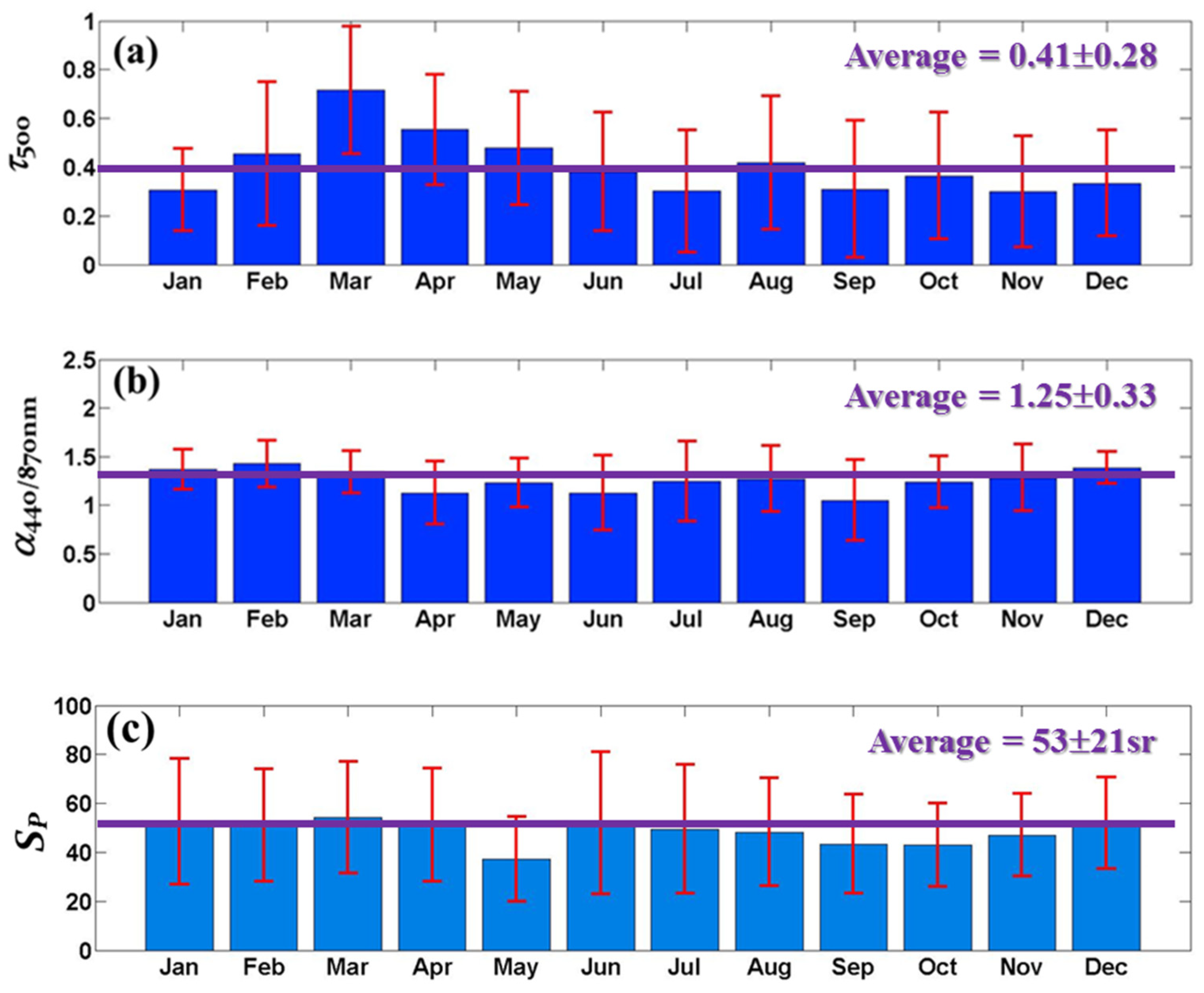
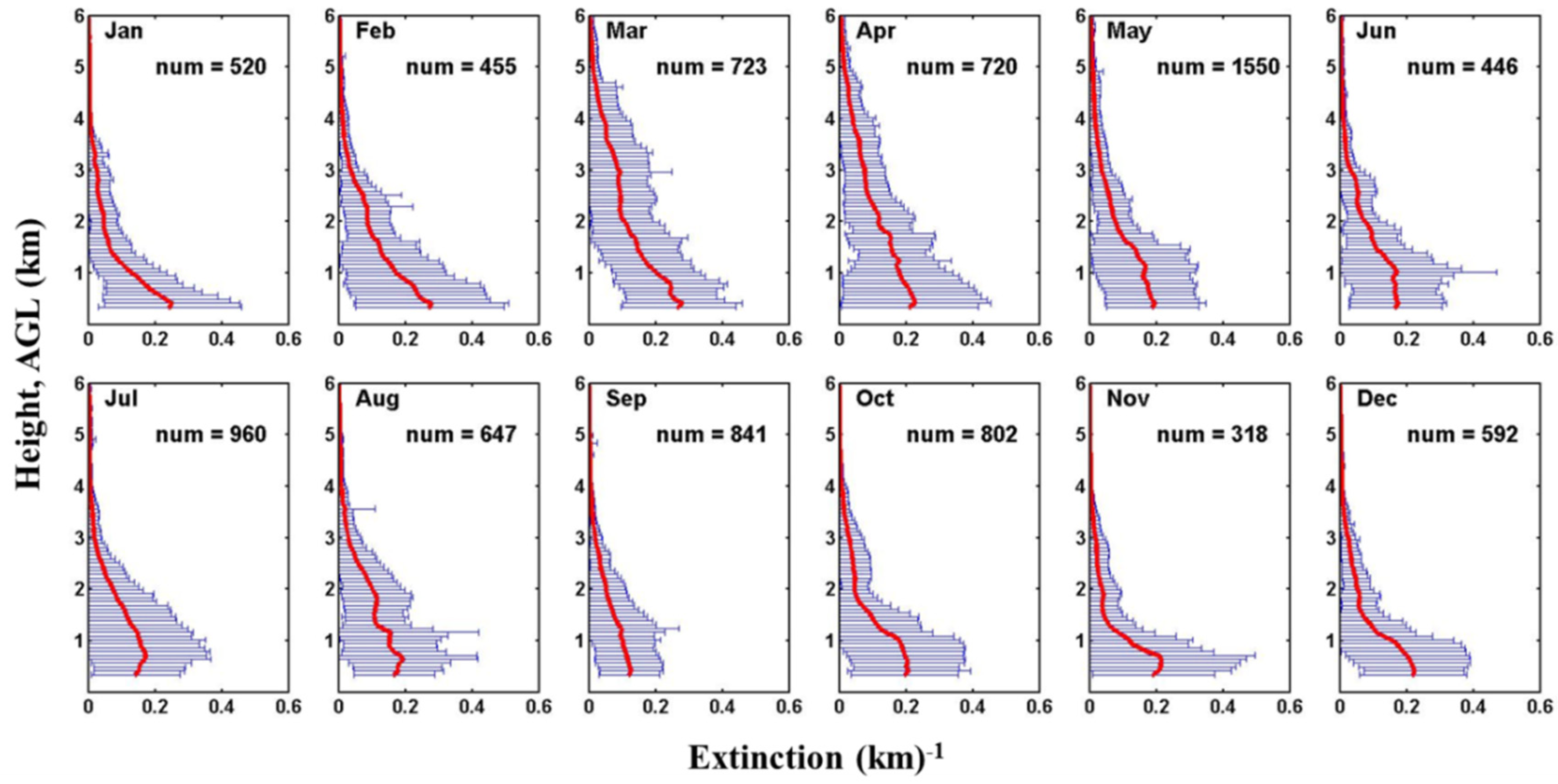
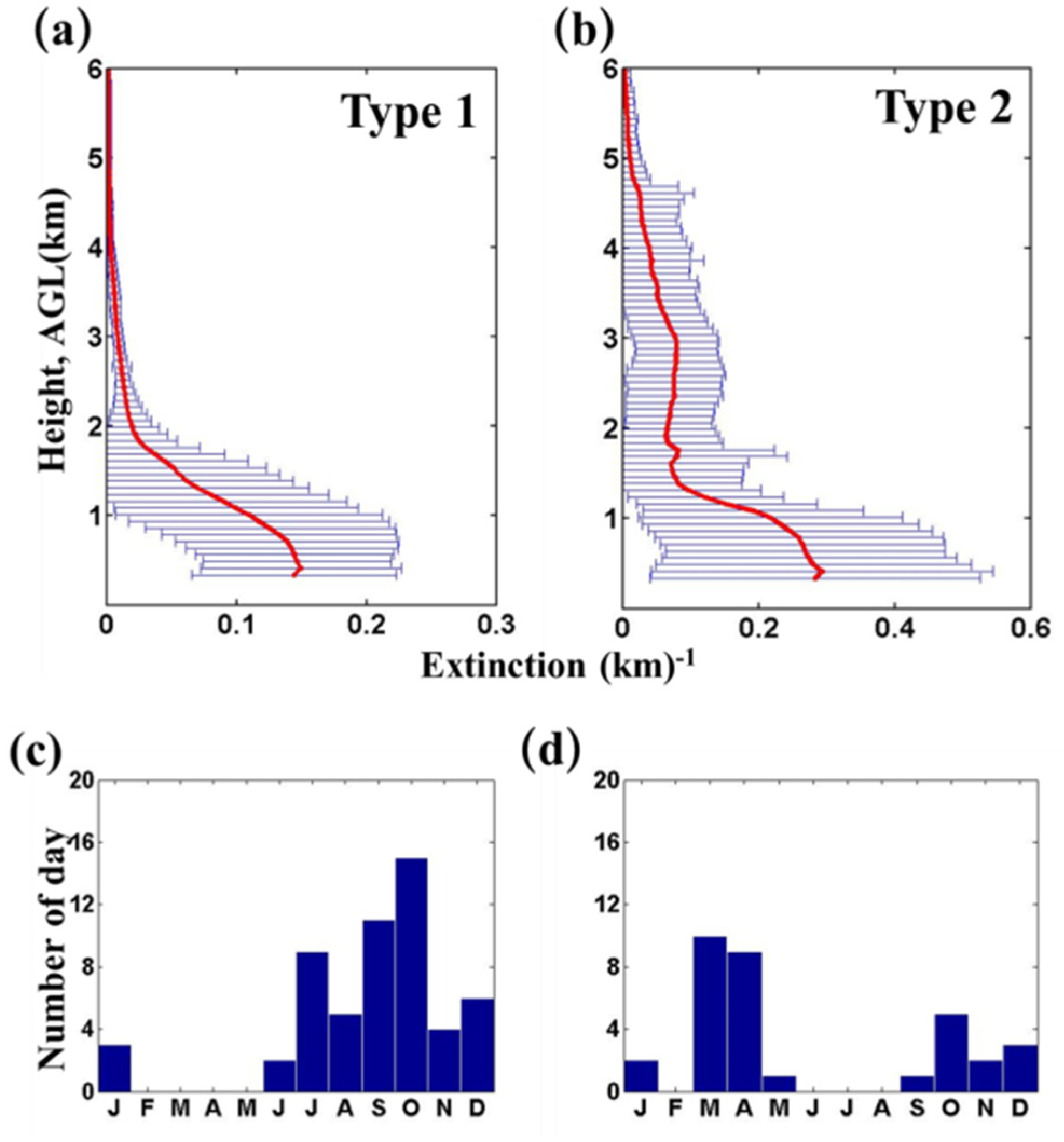


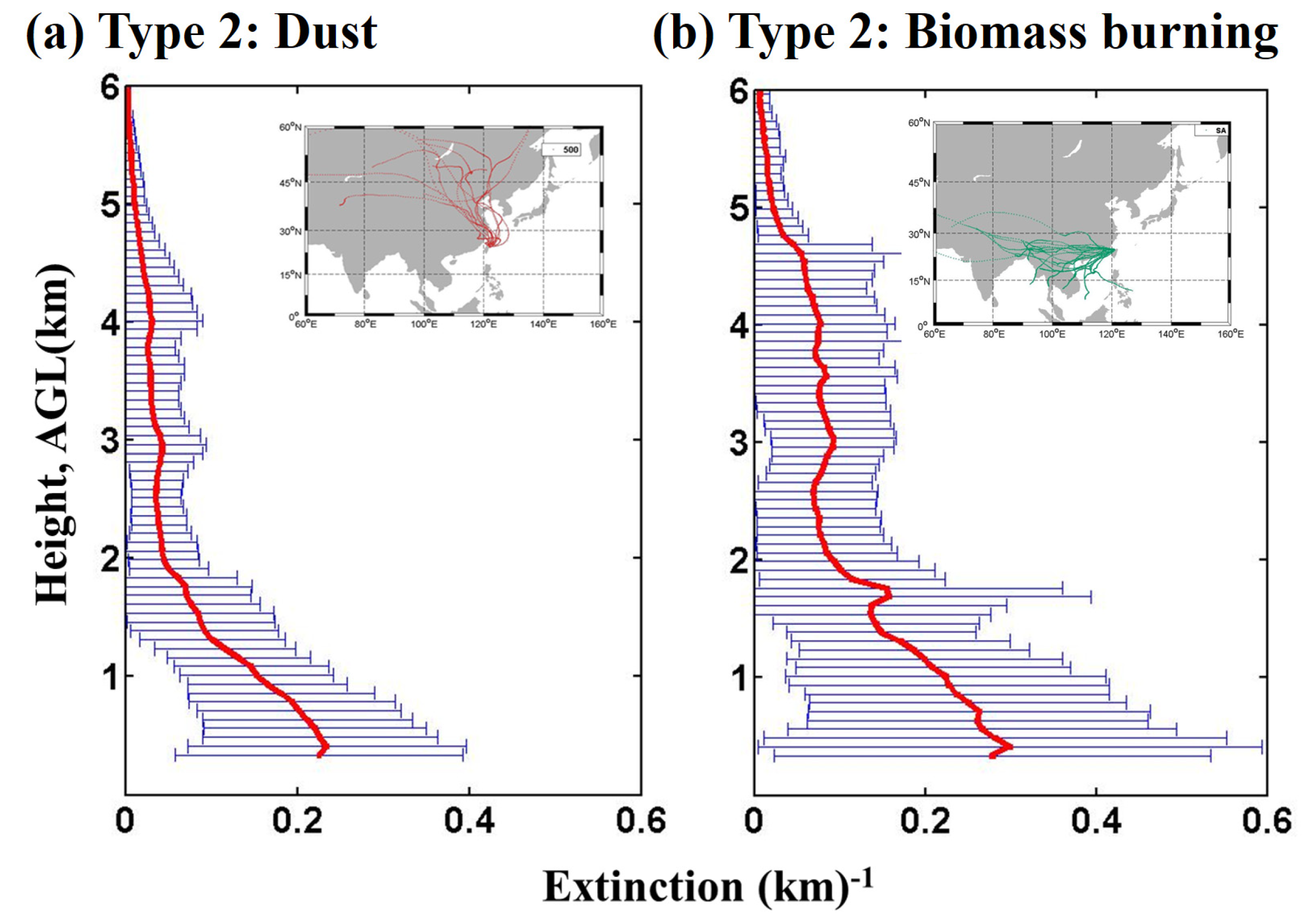
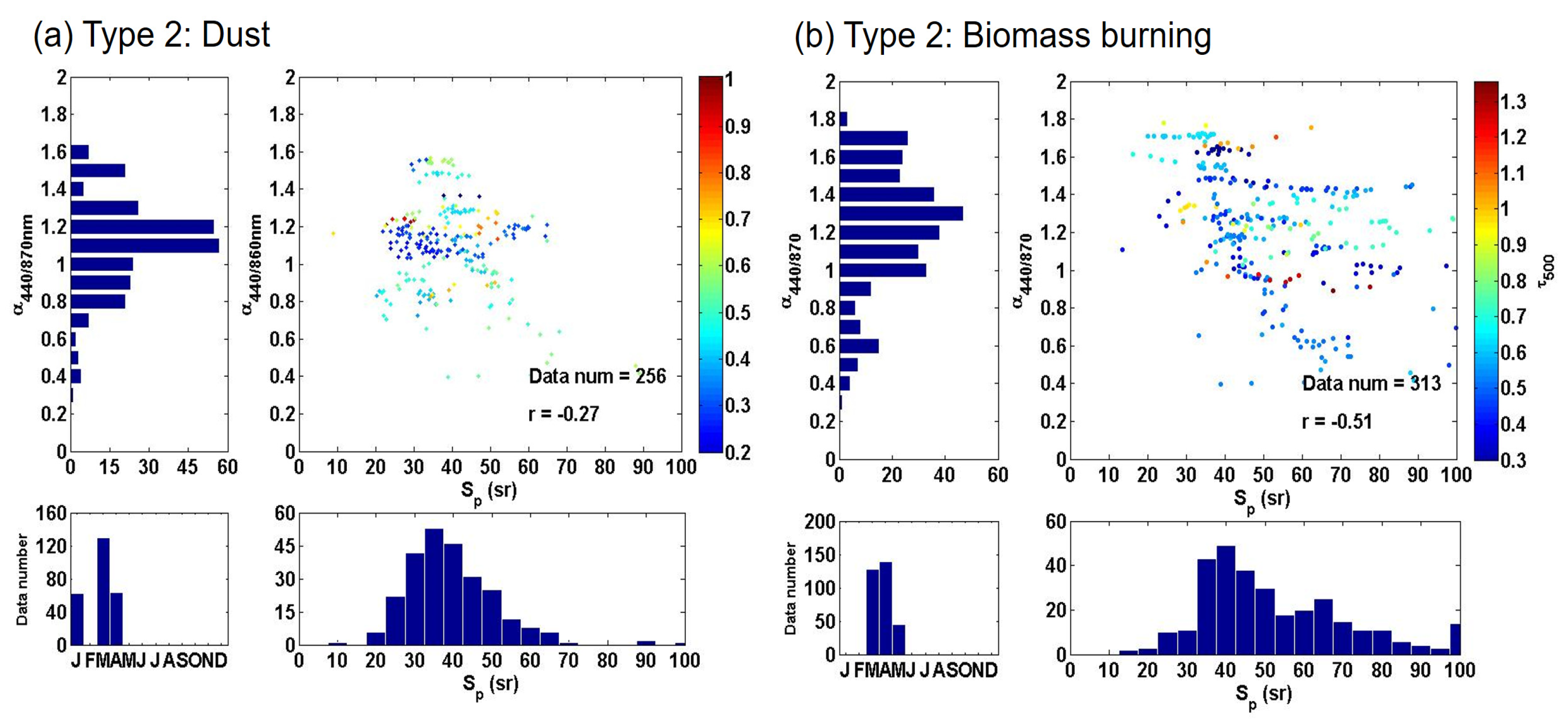
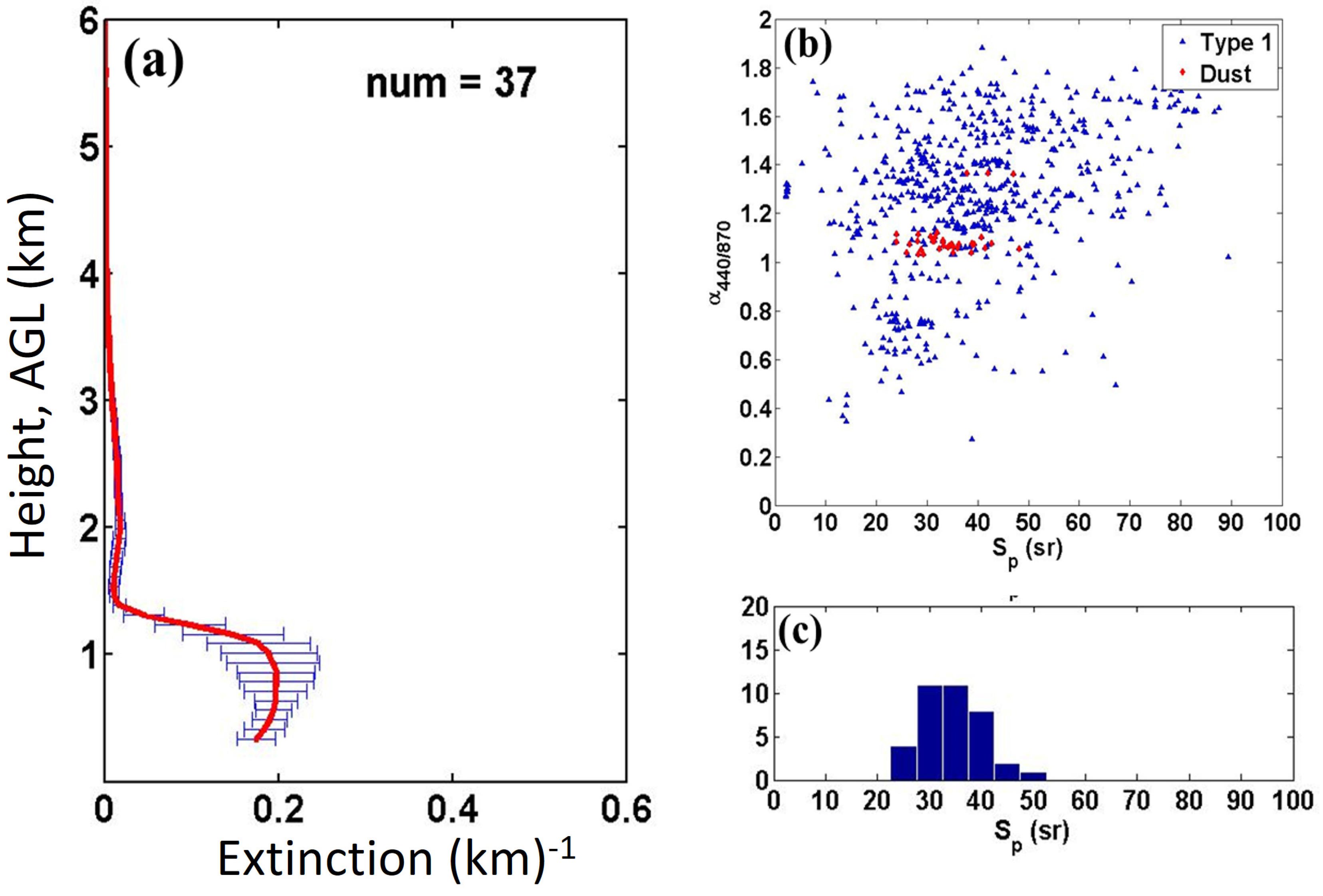
| Aerosol Optical Property | Type 1 | Source Region of Type 1 | ||
|---|---|---|---|---|
| PO | AC | SA | ||
| Data Number | 649 | 59 | 458 | 154 |
| τ500 | 0.21 ± 0.1 | 0.19 ± 0.1 | 0.24 ± 0.11 | 0.19 ± 0.08 |
| α440/870 | 1.29 ± 0.30 | 1.24 ± 0.31 | 1.34 ± 0.19 | 1.32 ± 0.32 |
| Sp [sr] | 39 ± 17 | 30 ± 12 | 39 ± 16 | 38 ± 17 |
| ω440 | 0.93 ± 0.02 | 0.96 ± 0.03 | 0.91 ± 0.06 | 0.91 ± 0.07 |
| g440 | 0.77 ± 0.03 | 0.77 ± 0.02 | 0.72 ± 0.04 | 0.72 ± 0.03 |
| nr | 1.46 ± 0.06 | 1.46 ± 0.05 | 1.45 ± 0.06 | 1.46 ± 0.06 |
| ni | 0.0055 ± 0.002 | 0.0033 ± 0.0037 | 0.0031 ± 0.0037 | 0.0054 ± 0.0036 |
| Aerosol Optical Property | Type 2 | Emission Source of Type 2 | |
|---|---|---|---|
| Dust | Biomass Burning | ||
| Data Number | 503 | 256 | 313 |
| τ500 | 0.51 ± 0.22 | 0.45 ± 0.16 | 0.58 ± 0.20 |
| α440/870 | 1.23 ± 0.26 | 1.10 ± 0.24 | 1.22 ± 0.32 |
| Sp [sr] | 52 ± 23 | 40 ± 16 | 53 ± 21 |
| ω0 | 0.93 ± 0.02 | 0.96 ± 0.03 | 0.93 ± 0.02 |
| g | 0.77 ± 0.03 | 0.77 ± 0.02 | 0.76 ± 0.02 |
| nr | 1.46 ± 0.06 | 1.46 ± 0.05 | 1.48 ± 0.03 |
| ni | 0.0055 ± 0.0020 | 0.0033 ± 0.0037 | 0.0054 ± 0.0036 |
© 2020 by the authors. Licensee MDPI, Basel, Switzerland. This article is an open access article distributed under the terms and conditions of the Creative Commons Attribution (CC BY) license (http://creativecommons.org/licenses/by/4.0/).
Share and Cite
Wang, S.-H.; Lei, H.-W.; Pani, S.K.; Huang, H.-Y.; Lin, N.-H.; Welton, E.J.; Chang, S.-C.; Wang, Y.-C. Determination of Lidar Ratio for Major Aerosol Types over Western North Pacific Based on Long-Term MPLNET Data. Remote Sens. 2020, 12, 2769. https://doi.org/10.3390/rs12172769
Wang S-H, Lei H-W, Pani SK, Huang H-Y, Lin N-H, Welton EJ, Chang S-C, Wang Y-C. Determination of Lidar Ratio for Major Aerosol Types over Western North Pacific Based on Long-Term MPLNET Data. Remote Sensing. 2020; 12(17):2769. https://doi.org/10.3390/rs12172769
Chicago/Turabian StyleWang, Sheng-Hsiang, Heng-Wai Lei, Shantanu Kumar Pani, Hsiang-Yu Huang, Neng-Huei Lin, Ellsworth J. Welton, Shuenn-Chin Chang, and Yueh-Chen Wang. 2020. "Determination of Lidar Ratio for Major Aerosol Types over Western North Pacific Based on Long-Term MPLNET Data" Remote Sensing 12, no. 17: 2769. https://doi.org/10.3390/rs12172769
APA StyleWang, S.-H., Lei, H.-W., Pani, S. K., Huang, H.-Y., Lin, N.-H., Welton, E. J., Chang, S.-C., & Wang, Y.-C. (2020). Determination of Lidar Ratio for Major Aerosol Types over Western North Pacific Based on Long-Term MPLNET Data. Remote Sensing, 12(17), 2769. https://doi.org/10.3390/rs12172769







